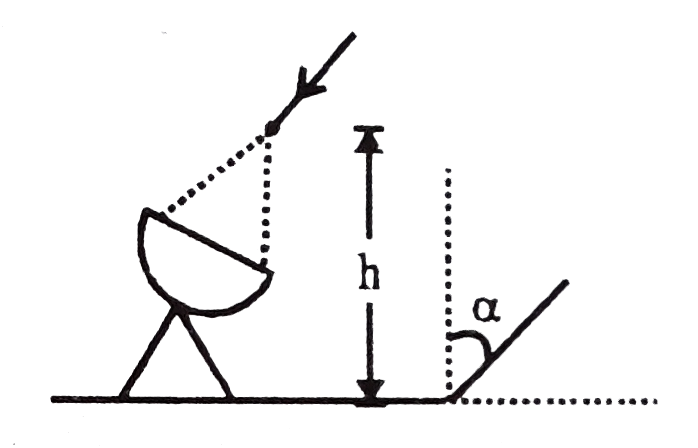A source emits electromagnetic waves of wavelength 3 m. One bema reaches the observer directly and other after reflection from a water surface, travelling 1.5 m extra distance and with intensity reduce to (14) as compared to intensity due to direct bema alone. The resultant intensity will be :
(14) fold
(34) fold
(54) fold
(94) fold
The correct Answer is:D
At reflection at denser medium, the phase difference is π & path difference is λ2
∴ Total phase difference =π−π=0
Hence, resultant amplitude is
=√I+√I4=32√I
Then intensity = (32√I)2=94I.
Topper's Solved these Questions
- WAVE OPTICS BOOK - MODERN PUBLICATIONCHAPTER - WAVE OPTICS EXERCISE - MCQ LEVEL -1 (ASSERTIONS)
3 Videos
- WAVE OPTICS BOOK - MODERN PUBLICATIONCHAPTER - WAVE OPTICS EXERCISE - MCQ LEVEL -1 (PARAGRAPH QUESTIONS )
34 Videos
- WAVE MOTIONBOOK - MODERN PUBLICATIONCHAPTER - WAVE MOTIONEXERCISE - RECENT COMPETITIVE QUESTIONS
18 Videos
- WORK , POWER , ENERGY AND COLLISIONSBOOK - MODERN PUBLICATIONCHAPTER - WORK , POWER , ENERGY AND COLLISIONSEXERCISE - Revision Test
40 Videos
Similar Questions
Wave from two source, each of same frequency and travelling in same direction, but with intensity in the ratio 4 : 1 interfere. Find ratio of maximum to minimum intensity.
View SolutionRadio waves coming at ∠α to vetical are received by a radar after reflection from a nearby water surface and directly .what should be height of antenna from water surface so that it records a maximum intensity.(Wavelength =λ)

View Solution
Knowledge Check
A source emits electromagnetic waves of wavelength 3m. One beam reaches the observer directly and other after reflection from a watersurface, travelling 1.5m extra distance and with intensity reduced to 1/4 as compared to intensity due to the direct beam alone. The resultant intensity will be :
A(1/4)radB(3/4)radC(5/4)radD(9/4)radThere is a source emitting electromagnetic waves of wavelength 2m . One light ray reaches a point P in space direcly and the other ray reaches the same point P after travelling 1m extra distance and after getting reflected from a glass plate. Let I be the original intensity corresponding to both rays and glass plate reflects only 25% of incident energy. Resultant intensity at point P will be
A3I/2B9I/2C9I/4D0The wave reaching the receiving antenna will have maximum intensity if the direct wave & wave after reflection from earth's surface
Aare out of phase by 90∘Bare out of phase by 270∘Care in phaseDNone of these
Radio waves coming at ∠α to vetical are received by a radar after reflection from a nearby water surface and directly .what should be height of antenna from water surface so that it records a maximum intensity.(Wavelength =λ)

View SolutionA point source S emits light of wavelength 600 nm. It is palced at a very small distance from a flat reflecting mirror AB. Interface. Frignes as observed on the screen placed parallel to reflecting surface at very large distance D from it. The ratio of minimum to maximum intensities in the interference frignes formed near the point P is 1/6.
Q. What is the percentage intensity of the reflected light to the intensity of the reflectd light to the intensity of incident light?

View SolutionA point source S emits light of wavelength 600 nm. It is palced at a very small distance from a flat reflecting mirror AB. Interface. Frignes as observed on the screen placed parallel to reflecting surface at very large distance D from it. The ratio of minimum to maximum intensities in the interference frignes formed near the point P is 1/6.
Q. If the intensity of P correspoonds to a maximum, calculate the minimum distance through which the reflecting surface AB should so that intensity at P again becomes maximum.

View SolutionA point source S emits light of wavelength 600 nm. It is palced at a very small distance from a flat reflecting mirror AB. Interface. Frignes as observed on the screen placed parallel to reflecting surface at very large distance D from it. The ratio of minimum to maximum intensities in the interference frignes formed near the point P is 1/6.
Q. What is the percentage intensity of the reflected light to the intensity of the reflectd light to the intensity of incident light?

View SolutionA point source S emits light of wavelength 600 nm. It is palced at a very small distance from a flat reflecting mirror AB. Interface. Frignes as observed on the screen placed parallel to reflecting surface at very large distance D from it. The ratio of minimum to maximum intensities in the interference frignes formed near the point P is 1/6.
Q. If the intensity of P correspoonds to a maximum, calculate the minimum distance through which the reflecting surface AB should so that intensity at P again becomes maximum.

View Solution
